A Very Serious German Wine Adventure with Scenes from the Rheingau and Nahe at Harvest 2016.
By Kerry Winslow, grapelive.com

In October of 2016 I went to Germany on a mini vacation, staying five days in total, it was a busy time with harvest having already started, but I did manage to visit four wineries, Leitz, Kruger-Rumpf, Schlossgut Diel and Spreitzer, all welcomed me with warm and graciousness beyond all expectations, especially considering my timing. Being in the right place at the right time never seems to describe me, but I was lucky this week and a glimpse of the beauty and stress of harvest in some of the world’s most beautiful regions, the Rheingau and the Nahe, two of the best for Riesling you can find. While I adore the Mosel and the Pfalz, I happened to focus my limited time to mainly to the Rheingau around Rudesheim and the Nahe closer to the Bingen side as I was mostly on foot, train and ferry while staying in Rudesheim on the Rhein. The hiking here is thrilling and includes dramatic vistas of the river, forest and steep vineyards, and since this was mostly a vacation get away I didn’t make all that many arrangements or appointments, I certainly wished I could have seen and met up with more people, for that I’m sorry to those I couldn’t get to, but still I got to see some old friends and a few new ones, and I got unequaled access to the whole harvest experience at Weingut Leitz, toured their vines with Markus Roll, Leitz’s dynamic young vineyard manager, as well as have a few wonderful diners with my friend Johannes Leitz, one of the world’s best vignerons and all around fantastic person.
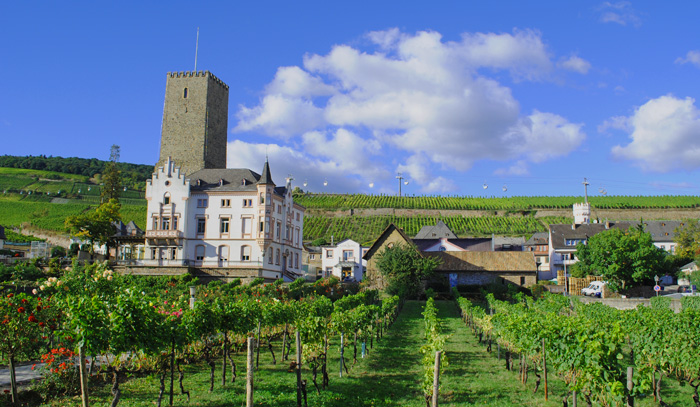
It was also great to visit Andreas Spreitzer and family at Weingut Spreitzer in the upper Rheingau in Oestrich-Winkler, who in 2015 turned out some of the old wineries best wines ever and is a winery on the rise. Crossing the Rhein, to Bingen and on the Dorsheim, I got to see Georg and Stefan Rumpf bring grapes in and tour their very old cellar as well as getting a are chance to taste at Schlossgut Diel as they brought gorgeous Pinot Noir into their cellar! Even with all the craziness and stress, everything went smooth as silk and I am grateful for all the warm and kindness I felt from everyone. 2016 didn’t look good in July when they all had a deluge of rain and cold weather, but a miracle came in late August when the sun returned and gave real salvation and bright days, and through September things came back on course so much so that now in October the Riesling grapes look and taste fantastic, and with the cool weather as I write they will be able to pick at a more leisurely pace and give the grapes a longer hang time for the more serious bottlings, and even the Pinot Noir came in beautiful, though careful sorting and de-stemming was employed.
The Rheingau is a Region Re-discovering it’s Historical Greatness and Finding it’s Place in the Modern World!
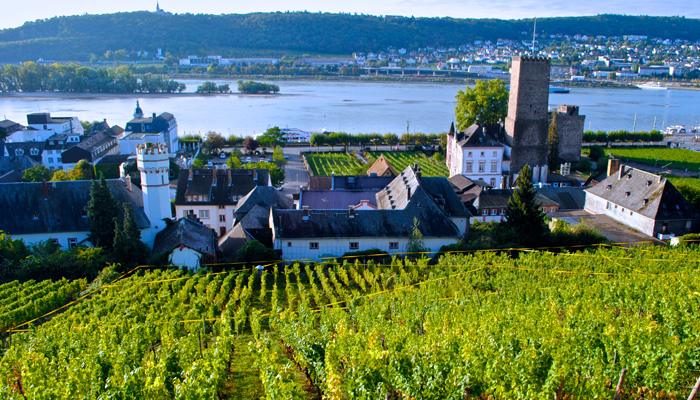
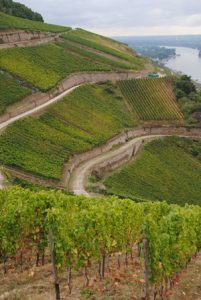
Rudesheimer Berg “Magic Mountain” I love this place, it is one of my favorite spots in the world, I first came here in 2009 and hiked these vineyards, and I am still in awe of Rudesheimer Berg, from Hinterhaus below Rottland, and Roseneck to the top of Kaisersteinfels, as well as Drachenstein and Ehrenfels castle, Schlossberg, this is a breathtaking experience, with every labored step up through these vines a cherished moment in time, beautiful and historic. This should be a world heritage site no question. Hundreds of years as the world’s most treasured wine center, the Rheingau has a long history of trade, from the Romans to the church, this was the spot and Riesling was (and is now) the shinning star! If you really love wine, historical sites and the outdoors, and especially if you are fit and don’t mind a little exercise, you’ll need to visit Rudesheim… Weingut Leitz enjoys some of the very best plots in these Crus, and his team is keeping them in, from what could see, the best shape, in fact they are spectacular! Johannes Leitz makes some of the most drinkable and pleasing wines in the world, he is a great producer, a great and tireless ambassador for the Rheingau and a most serious and thoughtful winemaker that continues to reach for new heights. Every time I see him I learn volumes of new information, see a whole new world and feel even more passionate about these wines and especially this very special place, it’s funny we all know the Rheingau, or think we do, but is has many surprises and in fact it is one of the smaller wine regions in Germany, almost twice as small as the Nahe by comparison, which is small too!
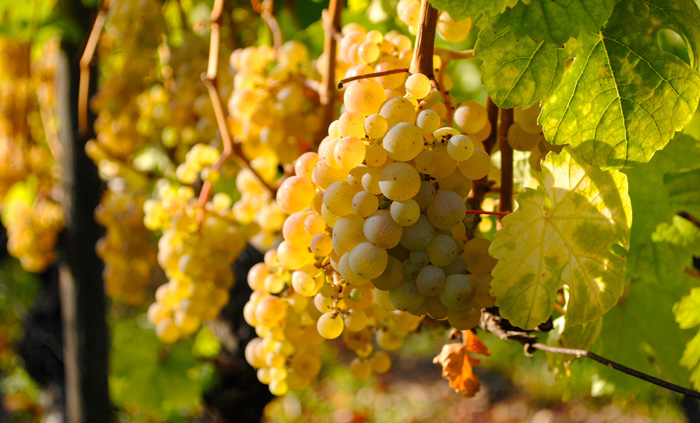
I look at the Rheingau, rightly or wrongly in three area, Rudesheimer Berg, the upper Rheingau at the widest part of the Rhein River, that includes many terroirs, and Assmannshausen, a shrine to Pinot Noir. Rudesheimer’s main crus, Roseneck, Rottland, Schlossberg and Kaisersteinfels are mostly slate influenced with some red quart, while the Drachenstein a long thin band above has a quartzite influence with some loam and slate, each is unique, this is home to Grosses Gewachs or Grand Cru and in the case of Drachenstein, Erste Lage or Premier Cru Trockens the most serious and dry of German wine overseen by the VDP control, but also you’ll find some of the world’s greatest off dry and or semi sweet wines too, while the world is screaming for the dry wines, you must not dismiss the fine Kabinett and Spatlese, as well as the non classified QbA’s that can have various levels of sugar, these are not dessert wines that can be just as monumental as the Trockens, when balanced and full of acidity they are mind-blowing.
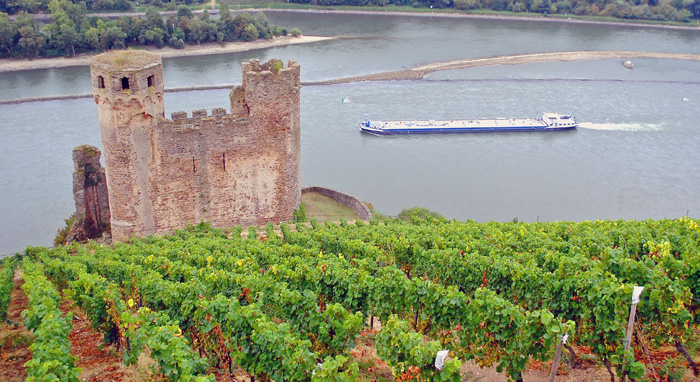
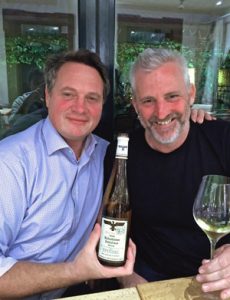
The Leitz Kabinett and Spatlese wines are especially intriguing with detail, clarity and length, in fact they are in some cases more rewarding than GG’s, don’t get blinded by the false sugar issue, these are very sexy wines with terroir personalities to cherish, in particular the 2015 Weingut Leitz Riesling Spatlese Rudesheimer Berg Roseneck stands out, it is simply an awesome white wine of intensity and class with a lavish mouth feel rater than sweetness, search it out and enjoy it’s purity and opulence! The Leitz 2015 GG’s remind me of very young Grand Cru Chablis, tight and un-evolved, without question these are superior examples, but will exceptional with more age! Mind you, they aren’t bad now, especially as I was able to enjoy/drink them in their individual vineyards and terroir! Of the three 2015 GG’s I tried, Roseneck, Schlossberg and Kaisersteinfels, it’s the Schlossberg Ehrenfels that at this early stage stole my heart, plus the view wasn’t bad! Other notable Leitz wines include, the fruit driven 2015 Dragonstone, which is noticeably drier this vintage with it’s lowest RS to date, the steely Drachenstein Erste Lage Trocken and the absolute best value 2015 Rudesheimer Berg “Magic Mountain” a cuvee that comes from only top GG sites and sells for under twenty bucks! Leitz sets a high bar in the Rheingau with a tremendous set of wines that range from playfully fun to ultra serious, but all of the wines set standards for quality in level and offer stylish fun, seeing behind the scenes at Leitz was an insight few ever get the chance to experience, I found the commitment, ethics and dedication a thrill to witness and a joy to be part of. Attention to detail,from packaging, marketing, vineyard work and winemaking is second to none at Leitz, and while they use some high tech processes and innovate, these are wines of soul and a true love of place. Watch this space, the future is bright and full of excitement here!
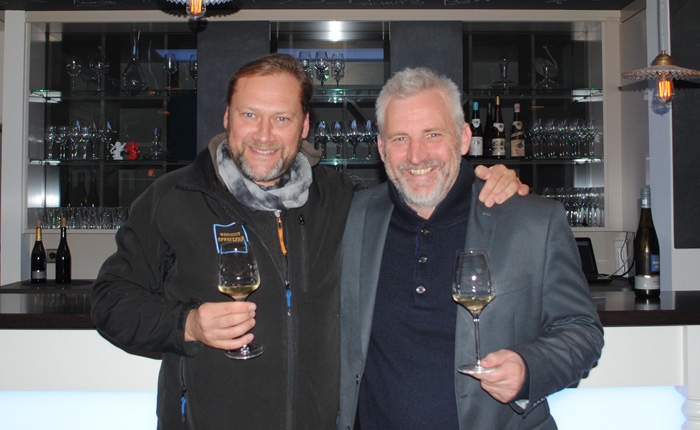
Andreas Spreitzer of Weingut Spreitzer picked me up in his Land Rover and took me on a tour of his vines near Geisenheim, Hattenheim and Eltville, but mostly his prized sites in Oestrich-Winkel above where the Rhein reaches it’s widest point. Spreitzer explained to me the almost lake effect his region gets and showed me the many micro climate and soils here in the upper Rheingau, it was like being exposed to a whole new world, vastly different than my experience in Rudesheim and my limited time in the Nahe. It was amazing to see each of these terrors translated through each different wine at Spreitzer, especially with the glorious 2015 vintage providing the perfect path to enlightenment on this area. Andreas and Bernd have really in recent vintages especially have fine tuned their lineup and crafted some excellent wines. The 2015 Grosses Gewachs from Spreitzer are decedent, opulent and engaging wines which have blossomed into glorious Rieslings since being bottled, I had found them closed and extremely tight as barrel samples when Andreas first sampled me on them at an early Terry Theise tasting, but now they are some of the best yet from this estate and rival some big names! There are many gems and wonderful wines in the latest set of releases here, in particular was the amazing old vine 2015 Hallgartener Hendelberg Alte Reben Trocken, only slightly less dense than the three GG’s, the Hallgartener Hendelberg shows a delicacy and mineral clarity that is truly exceptional, this might be my dark horse or sleeper wine of the vintage in the Rheingau! The mix of loess and loam, clay, red quartz and light slate of these vineyards makes for a head spinning mix of complex flavors! Other Spreitzer wines that need mentioning are without question include the lovely and over delivering 2015 Ostrich Lenchen Riesling Kabinett, the vigorous and thrilling 2015 Ostricher Doosberg Alte Reben Riesling Trocken and the beautifully perfumed and seductive 2015 Winkeler Jesuitengarten Alte Reben Riesling Feinherb, as well as the succulent Spatlese from the same vineyard, all of these stood out and deserve your attention, this is an area that needs a serious re-discovery!
The Nahe’s Glorious Future is Here Now!
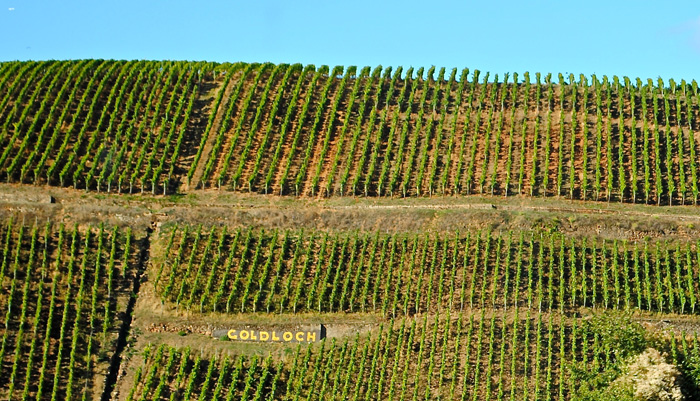
A visit to the Nahe at harvest is special, getting to meet up with two of the regions emerging talents, in a region full of very busy winemakers, is even more special! I followed by a day, a visit to the region by one of Germany’s most famous wine critics, and who reviews for Robert Parker, Stephan Reinhardt, so I guess in many ways I’m grateful, as both Kruger-Rumpf and Schlossgut Diel, the two brilliant family wineries I was lucky enough to see, had a extra rare bottles open, so Thanks Stefan! Getting to the Nahe, in my case from Ruedesheim without wheels, I took the ferry boat to Bingen, where Georg Rumpf picked me up with a big smile and a convertible Saab, borrowed from his mom, as his more workman and family like car was out in the vineyards with his crew, and off we went, into the heart of Bingen, a small old town across the Rhein from Ruedesheim, and the gateway to both the Nahe and the Rheinhessen, first stop was a brand new vineyard that Rumpf has acquired and have made one vintage from in 2015, the Abtei. The Abtei is an intense site, super steep and with great south facing slopes, it is set in mixed quartz and has some slate underneath it’s thin top soil, Georg jokingly calls it a hobby vineyard, because the cost of farming and adapting the vines here is and will be costly, but there is real potential here for beautiful wines, in fact I loved the 2015, the first try at wines from here, it’s vital and lively with great extract and full flavors. After this we stopped in at the winery where the crew was bringing in some Sauvignon Blanc, Georg was needed and jumped back into winemaker mode, as I passed on the man behind Kruger-Rumpf’s modern success, Stefan Rumpf, Georg’s dad and semi retired grandpa, he showed me most of wines, while Georg worked feverishly in the cellar.
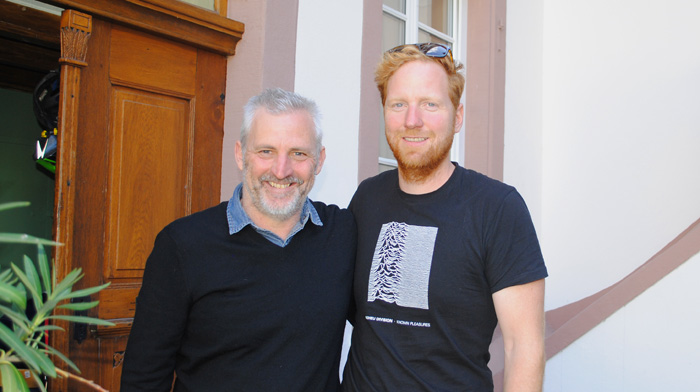
It was quite a cascade of wine that was presented to me with a few vintage items that shined including the 2001 Dorsheimer Burgberg, gorgeously full bodied dry and length, the 2006 Pittersberg GG from Munsterer’s Grand Cru vines, a delicate and refined effort that got more interesting and lengthy in the glass, even though it was opened the day prior, and the nervy and intense 2010 Pittersberg GG which is just hitting it’s stride and shows of the house style very well. Kruger-Rumpf is smaller than I had thought and is a really tight family affair, everyone is involved and the love of place is in the air, it’s all hard work, but with laughter and passion. I was impressed with all things Kruger-Rumpf, especially the current set of 2015’s, of course, they are stand out wines even in a region full of stars! Looking across the Nahe to the southeast is Scharlachberg, a Grand Cru site that is part of Bingen, but somehow within the Rheinhessen, the Rumpf’s have vines there to, and tasting the GG Scharlachberg was very memorable, it’s a massive wine with great detail, density and depth, it was one of my favorites of the lineup, even if it wasn’t strictly a Nahe offering, wink wink.
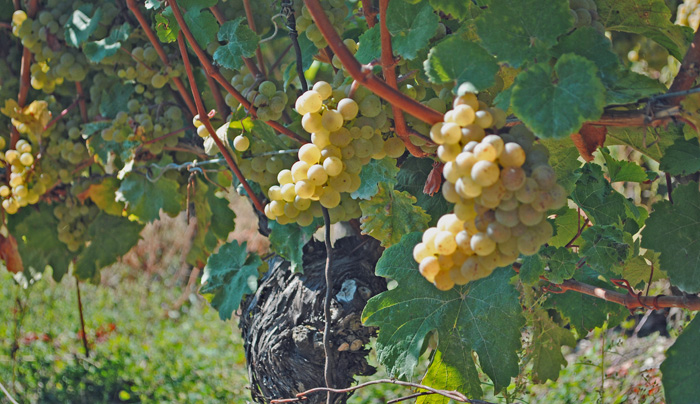
It was fun to lunch with the family and cellar crew, simple food and Kruger-Rumpf’s Sauvignon Blanc really hit the spot. Getting back to the wines, I must mention the Rumpf’s Scheurebe, one of the best examples of this varietal on the planet! Along with Muller-Catoir in the Pfalz, Kruger-Rumpf does stunning Scheurebe, it’s a must try wine, in particular look for the exotic and sexy 2015 Scheurebe Spatlese, again please, please forget seeing the Spatlese at all, this wine is decedent, opulent and lush, but it isn’t overtly sweet, it is deserving of your time and respect as a table wine, forget must weight and sugar levels and reap the rewards of an open mind and happy palate! I was able to taste almost ready to pick Scheurebe off the vine with Stefan and wow, it had a burst of tropical fruit like I’ve never experienced from grapes of the vine, pineapple, guava and kiwi exploded in my mouth, now I can’t wait for their 2016! One other wine that stood out for class and value was the remarkable Munsterer Kapellenberg Kabinett 2015, this is a stupidly good Riesling that feels balanced, pure and drier than expected on the palate, if you are a Riesling fan or bargain hunter this is a wine to look for! If you want authentic wine, made by hardworking and warm people, get Kruger-Rumpf, you can taste love of family and terroir in all of their wines, do not miss the 2015’s.
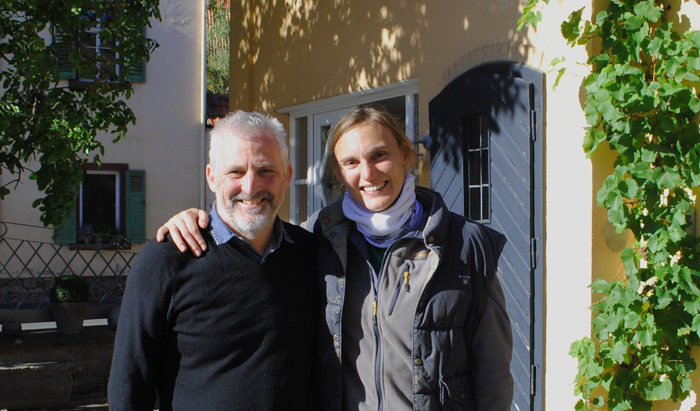
In a great bonus to my Kruger-Rumpf visit, as Georg got busy, he called over to Sylvain Taurisson, Caroline Diel’s husband at Schlossgut Diel, and he agree to take me at the winery, even though he was busy cooking for the vineyard and cellar crew! It’s nice to have connections, and Stefan drove me over to near Dorsheim and the Berg Layen castle that is Schlossgut Diel’s home, checking in on a few vineyards on the way. I was surprised to run into Armin Diel himself, though he quickly passed me on to Sylvain after a brief hello, but that was all good, as I really enjoy Sylvain’s French humor and joy of life addictive, and even though he was juggling many chores he made my day that much the better for his charm and class, it didn’t hurt either when he opened a fresh bottle of Diel sparkling wine! And what a treat that was, the Schlossgut Diel Sekt Goldloch is one of the world’s best bubbly wines, with something crazy like 96 months on the lees, this one was from the 2008 vintage, it’s mind-blowing full of brioche, mineral intensity and with insane length with an ultra fine mousse, can you say better than Champagne? Maybe, but it’s a unique effort and a unicorn sparkler!
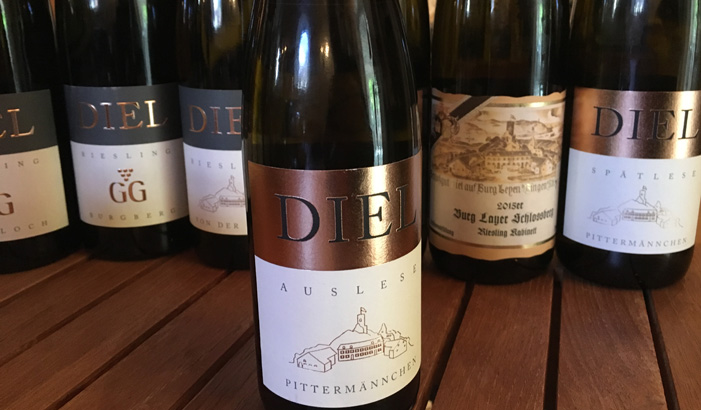
Caroline Diel is making some elite wines, and everything is so detailed and poised, and while never easy to find, there are some values in the lineup that merit note, especially the Terry Theise inspired Riesling Von Der Nahe Feinherb at about $24 is a great entry or gateway to the drier wines at Schlossgut Diel and the Dorsheimer Goldloch Kabinett with a touch more RS, but with succulent layers and immediate pleasures. But, of course, when you think of Diel you think of their top Trockens, the Goldloch GG in particular, and the Pittersmannchen GG, these Grosses Gewachs or Grand Crus really are the soul of Diel and rate as some of Germany’s greatest wines, and the 2015’s certainly are that. Trust me when I say, you cannot go wrong with all and all things Schlossgut Diel in the 2015 vintage! From Caroline’s glorious dry Rieslings to her Auslese sweeties, everything is beyond great, but don’t overlook the amazing Pittermannchen Spatlese if you want the best of both worlds, it’s a rich, layered and mineral driven beauty with near perfect balance, don’t let the sugar or must weight scare you, this is pure class with amazing cellar potential as well!

Caroline Diel the winemaker, is worldly and studied in her craft, her talent is on display in each and every wine at Schlossgut Diel, as well as her heart, the wines have her perfectionist focus and energy, this is especially true in her signature Pinot Noir, the “C” or her Cuvee Caroline, it is a gorgeous wine of elegance, graceful subtlety and is skillfully crafted with amazing attention to detail, some of her thoughts and methods might have come from when she did a spell at Romanee-Conti in Burgundy, even from a difficult vintage, such as 2014 was, the wine is truly captivating and seductive, it’s an awe inspiring effort that is worth every penny! Caroline Diel joins an elite group of Spatbugunder producers like Becker and Mayer-Nakel in making world beating Pinots from Germany, and I was able to see the magic happen here, as the Pinot Noir fruit was coming into the cellar, the 2016 is looking awesome, at least in the bins ready to be sorted the grapes looked fantastic, it will be good to take a mental note to get some in 4 years! Plus I can’t wait to see what she did with the 2015, which I sadly missed when visiting this time.
History Lessons and the Rise and Fall of Kabinett!
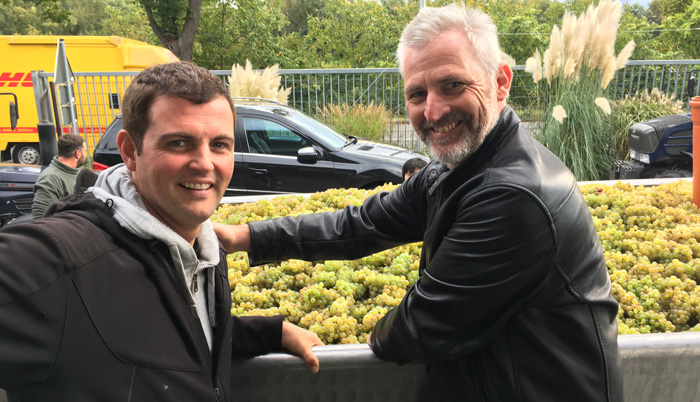
Kabinett was once the most prized wine of all, no I’m not kidding, and it still should be taken more seriously now, I am often mystified by peoples fear or dismissal of these lightly sweet Rieslings, and while I am an advocate for the dry or trocken wines the shear pleasure, flexibility and generous charm of Kabinett should not be forgotten. Kabinett Riesling with fresh crab is one of the best Food and wine pairings ever, but I like Kabinett with everything from smoked meats to tacos! The modern wine drinker needs to better understand these wines that offer so much for such a value price and find a place for them, they go with multi-ethnic and fusion cuisines, are refreshing and low in alcohol, perfect for summer and more complexity and charm than most other white wines in their class, plus if we are honest, and we are not, this fear of RS (read sugar levels) is pretty much bullshit anyway, most Chardonnay and modern Sauvignon Blancs from the new world most likely have as much sweetness or more than Kabinett level Rieslings! Really, and Riesling at least has less oaky/buttery character with bright zesty acids and true mineral tones. I’d rather have a Kabinett Riesling over a bland Pinot Grigio or oak chipped sickly cloying Chardonnay any day, but that’s just me it seems! This is a great time to re-discover Kabinett, especially these 2015 wines, which feel drier and have an array of complex flavors.
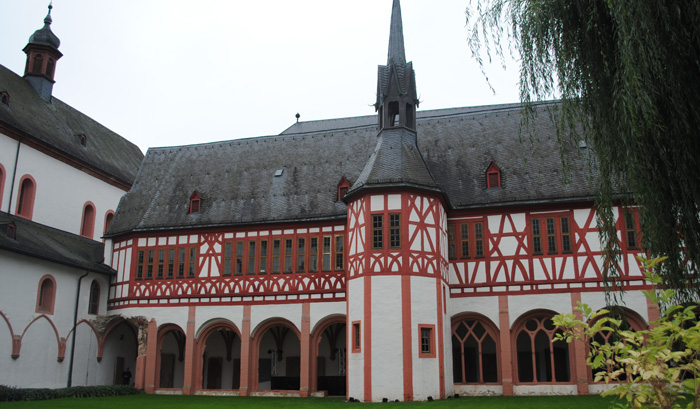
The monks at Kloster Eberbach had their own Kabinett cellar, it was where their most prized wines were kept, you can visit the old monastery today and see it, I was lucky enough to make my own pilgrimage this year with an excellent tour guide, Markus Roll of Weingut Leitz, this was a bit of Riesling lore I had not heard about or known. German wine law is strict and tricky, and it is in flux, so traditional Kabinett, Spatlese and Auslese are losing some of their prestige and appeal, as the wine industry tries to classify and regulate itself. The best and most useful English language explanation of German wine law and labelling is by Tim Gaiser, MS and can be reviewed on his blog at http://www.timgaiser.com/blog/understanding-german-wine, but for my purpose I’ll explain that Kabinett Riesling is classified by must weight or sugar in the grapes at harvest, the local term for this measuring is the Ochsle Scale, it is way of telling the amount of solids and sugar in the grapes compared similarly to the amount of water, and before your eyes glaze over, it is translated into a number, in the case of Kabinett that is 67-82 Oechsle (148–188 g/L sugar). What that means is that Kabinett level wines, yes do have sugar, but are usually high in acid and lighter in style giving them a delicately fruity taste. Interestingly Kabinett lost it’s prestigious place on top of the wine world, due to a fluke and a bishop with a sweet tooth! There is a statue at Schloss Johannisberg of a horseman, it is historic and cruel that Kabinett lost out, because of a lazy horseman, but it’s true that a couple hundred years ago, the monks sent a horseman to the Bishop to bless the approaching harvest so they could begin picking the grapes, well, the horseman come back as expected and the monks waited and waited as the grapes got riper and riper, it was thought maybe the horseman had spent his time with a lover, though eventually he did show up, but it was too late to make the traditional Kabinett style wine, hence the term Spatlese or late picked gaining favor, as when the Bishop tried this sweeter wine he hailed it as the best wine he’d ever tasted, much to the chagrin of the monks at Kloster Eberbach, though celebrated by sweeter wine producers, such as Schloss Johannisberg who still make celebrated Spatlese and honor the lazy horseman. I know I butchered Markus’ telling of the story, but I hope you can forgive me.
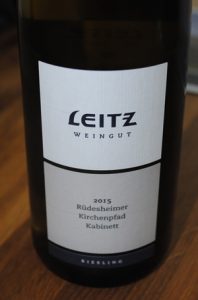
If you are curious about Kabinett Rieslings and want to try them, here are a few top producer recommendations for you: Selbach-Oster, Mosel, JJ Prum, Mosel, JJ Christoffel, Mosel, Willi Schafer, Mosel, Leitz, Rheingau, Spreitzer, Rheingau, Kruger-Rumpf, Nahe, Hexamer, Nahe, Schlossgut Diel, Nahe and especially Donnhoff, Nahe.
One of my favorites is the Leitz Rudesheimer Kirchenpfad Kabinett (pictured) this 2015 shines brightly with impressive detail and richness with lots of mineral and orchard fruits with plenty of brisk acidity to balance the sweetness.
My visit to Germany this October of 2016 was one of my career’s best and most eye opening wine travels, a much too short trip that with time and reflection has given me a wealth of new knowledge and respect for the terrors of the Rheingau, including the famed Rudesheimer, Assmannshausen and the upper Rheingau as well as part of the Nahe and a tiny piece of the Rheinhessen that touches Bingen. A grateful thanks to the wonderful and authentic people I saw and met on this trip, including my friends Johannes Leitz, Caroline Diel, Andreas Spreitzer, Stefan and Georg Rumpf as well as Markus Roll, Leitz’s vineyard and general manager that patiently toured me through almost every section of vines in the Rheingau and took me on a tour of Kloster Eberbach and taught me a brief history lesson of the region! This was my second visit to the Rhein, my first was in 2009, and I can promise you I’ll be going back repeatedly if life gives me that opportunity, it is one of the most beautiful and interesting places in the world, let alone the wine world, my few pictures here hardly due justice to this glorious place, I suggest you visit yourselves, after a five minute hike up the hill from Rudesheim was all it took to hook me in and make me a fan for life!